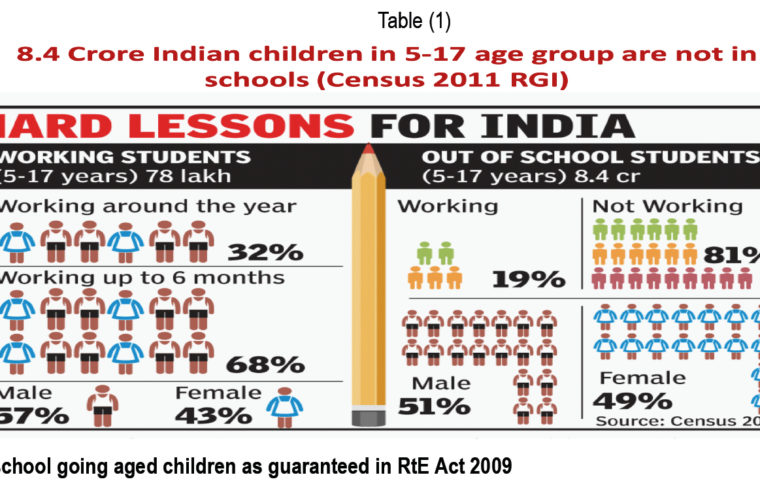Ramakant Rai
Convener – National Coalition for Education (NCE) – INDIA
India is a signatory to or participated in the United Nations Rights of the Child, United Nations Standard Rules on the Equalization of Opportunities, the Jomtien Declaration on Education for All and the Salamanca Statement and Framework for Action.
A child with disability should be educated, empowered and developed in such a way that he/she should feel mainstreamed in the society and become a fellow of social development. (Anonymus)
Introduction:
During the year 2015 the UN member states signed Sustainable Development Goals in its General Assembly. World community has also signed in “Incheon Declaration” called “Education 2030”. Having fully endorsed and embraced the vision, principles and targets of Education 2030, the member States, development partners and civil society organizations have the unique collective responsibility to carry the torch for this new global education agenda towards “ensuring inclusive and equitable quality education and lifelong learning opportunities for all” by 2030. This is a more ambitious goal than ‘Education for All’ (EFA) goal which remained unfinished in most of the countries including India.
Before we initiate the discussion on SDG let us clarify the inclusive education first. Sustainable Development Goals and the previous commitments in ‘Education for All goal’ prioritize inclusive education. Inclusive education means education of all children, with and without disabilities together in regular schools. It is an approach, which takes into account unique characteristics, interests, abilities and learning needs of all children. It is an attempt to meet the unique needs of every child in a regular school setting where all children, including those with disability, try to participate in all facets of school life. The goal is to provide accommodating and personalized education for all students within the context of a general educational classroom. The need of the hour is to develop a universal design of learning which makes learning joyful for all children. Basically, both concepts stand for a wide-ranging view of education in the frame of correlative challenges and objectives.
Why inclusive Education
is important?
One must acknowledge that a fairly large number of children remain out of schooling system for biological, social, economic and systemic reasons and so on. A key point is that crucial opportunities emerge from positive synergies between initiatives addressing social inequalities and catering to special needs of children. We often argue that the Sustainable Development Goals and inclusive education stand for an encompassing view of educational development. Whereas the EFA goals and the MDGs assumed that enrolment was a worthwhile benchmark on its own, these other perspectives vindicate closer attention to the synergies between the levels and the types of education. A set of political and practical implications follows, not least concerning lifelong education and learning, teachers‘ professional development, connections between education and other policy areas, and financing for educational development.
Wikipedia defines ‚ Inclusion‘ as an approach to educating students with special educational needs. Under the inclusion model, students with special needs spend most or all of their time with non-disabled students. Inclusive education seeks to address the learning needs of all children, youth and adults with a specific focus on those who are vulnerable to marginalization and exclusion. It implies all learners, young people – with or without disabilities being able to learn together through access to common preschool provisions, schools and community educational settings with an appropriate network of support services. It aims at all stakeholders in the system such as learners, parents, community, teachers, administrators and policy makers to be comfortable with diversity and see it as a challenge rather than a problem. Inclusive education means the education of all children, with and without disabilities together in regular schools. It is an approach, which takes into account unique characteristics, interests, abilities and learning needs of all children.
Puri and Abraham (2005) say that the concept of inclusion is based on the premise that all children and adults are a part of society and that the community helps the development of resources where all children are equally valued and have the same opportunities for participation. Then they go on to say that it is an ongoing process and not a fixed state. Mani (2000) states that one of the main features of inclusive education is development of capacity of the general education system to meet the educational services for children with disabilities. He says that inclusive education enhances the communication between children with disabilities and non-disabled children. He points out that inclusive education does not only enable the possibility of enrolling more children with disabilities since one resource teacher can be made responsible for 20-30 students with disabilities rather than have one teacher manage just eight children as recommended for special education. He recommends orientation and short-term training programmes for general teachers to overcome their inhibitions about children with disabilities in general schools. He elaborates on the theme with his thoughts on how to conduct the preparation of inclusion at the school level, preparation for inclusion at the teacher education front and other support services that are imperative for effective inclusion.
Children out of school;
A case of exclusion in India:
Registrar General of India has pointed out that during the Census 2011, 8.4 Crore children are not in schools. Out of this huge number of out of school children 19% are working children ( Child Labour). This is a sheer case of exclusion. (see table (1)
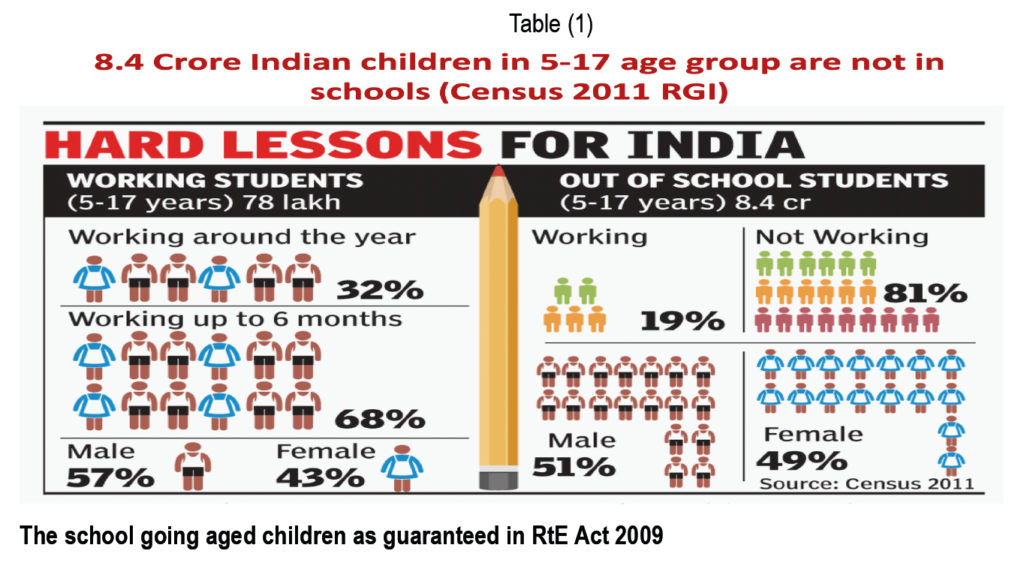
The Census 2011 enumerates school going aged children 233.52 Million. Out of this number only 199.71 Million were enrolled in the schools during the same academic year. In this way a nuge number of 33.81 Million children remained out of school during the academic year 2011-12. This was the year when most of the Indian states notified state rules i.e. Right of Children to Free and compulsory Education Rules guarantying universal education for all the children in school going age i.e. 6-14 year. This further gives the indication of exclusion of 33.81 Million hildren in India. (see table 2)
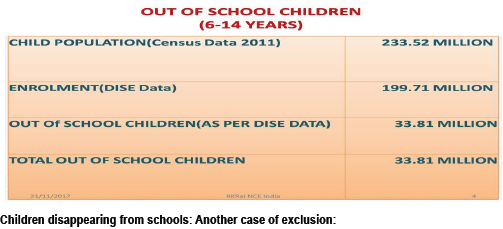
Children disappearing from
schools: Another case of exclusion:
A fairly large number of children are disappearing from our Elementary schools after the enactment of RtE Act 2009 in India. Table 3 shows that during 2011-12 only 663 children increased in elementary stage. In the following year 2012-13 the number further increased to the tune of 655211. Surprisingly in the following year 2013-14, 810690 children disappeared from schools. This trend is still continuing as 1232750 children in 2014-15 and 950398 children in 2015-16 disappeared from our schools including govt, and private schools.
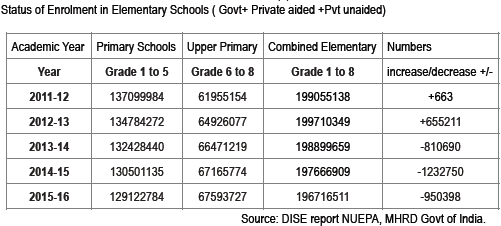
The Exclusion of disabled in India:
As per Census 2011, in India, out of the 121 Cr population, about 2.68 Cr persons are disabled’ which is 2.21% of the total population. In an era where ‘inclusive development’ is being emphasized as the right path towards sustainable development, focused initiatives for the welfare of disabled persons are essential. This emphasizes the need for strengthening disability statistics in the Country. As per RGI report of Census 2011, 45% of India’s disabled population is illiterate, as compared to compared to total 26% of all Indian illiterate population. Of persons with disability who are educated, 59% complete Class X, compared to 67% of the general population. Its an irony that the promise of universal access to education through the Sarva Shiksha Abhiyan (Education for All Movement), which promotes free and compulsory education for all children between the ages of six and 14, children with special needs form the largest out-of-school group in India doesn’t seem to be effective fully. Some 600,000 (28%) special needs children between six and 13 years of age are out of school, according to the 2014 National Survey of Out of School Children report, at a time when India has almost universal primary school enrolment.
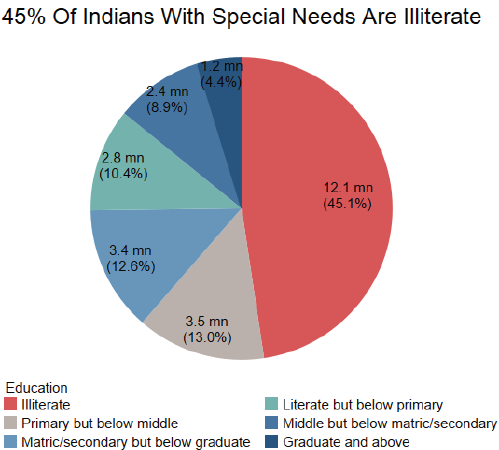
Among children with special needs, as many as 44% of children with more than one disability are out of school, and children with mental (36%) and speech (35%) disabilities are more likely to be out of school than those with other kinds of disability.
A higher percentage of children with hearing disability, orthopaedic /locomotive disability and visual disability go to school, with only 20%-30% failing to do so, according to this 2014 UNESCO report.
in the schools. This was the traditional exclusion from mainstreaming the disabled children by social interaction and upbringing in normal schools. This approach had far reaching adverse consequences on their overall development. And finally the separate schooling system remained excluded, and neglected. Most of the approaches have been to address the physical disability of child leaving behind other important socio economic, psychological, gender and other impediments affecting the education access and continuation in school systems.
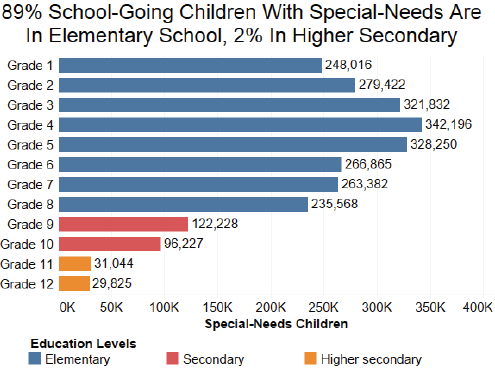
The policy mind set about
disabled children:
Traditionally every policy and initiative talked about separate schools for disabled children as they might not cope up with normal children.
The recent move about running general school for common children as well as disabled children has been widely welcomed. The Ministry of HRD promotes inclusive-education model where such children study in regular classrooms. The DISE data gives the picture that almost 90% of govt primary schools have ramps (the only consideration for disabled children is provision of ramps), There is acute shortage of teachers for differently abled children, teaching learning material and training to teachers in general.
The preparedness of our schooling
system for disabled children:
The Eighth All India School Education Survey (8th AISES) with reference date 30 September 2009, regarding schooling facilities for children with disabilities are as under:
• Out of a total 12,99,902 schools in the country, only 2,74,445 (21.11%) schools adhere to inclusive education for disabled children. Out of 2,74,445, the proportion of primary, upper primary, secondary and higher secondary schools adhering to inclusive education are 1,65,966 (60.47%), 77,757 (28.33%), 18,084 (6.59%) and 12,638 (5.07%), respectively.
• The number of teachers who have received training of at least two weeks in inclusive education is 80,942 (1.32%) out of the 58,76,273 total Teachers.
• The number of schools where special educator/ resource teachers never visited is 5,54,882
• (42.69%) whereas the schools where special educators/resource teachers visits the schools frequently or sometimes is 7,45,020 (57.31%).
• There are 8,35,287 differently abled students enrolled at all stages in the country. This comprises of children with different disabilities viz., visual impairment (29.16%), hearing impairment (14.47%), orthopaedic (locomotor) disability (25.05%), intellectual impairment (22.35%), multiple impairment (4.20%) and others (4.77%).
• Out of the total enrolment of differently abled students, 52.27%, 28.78%, 15.51%
• and 3.45% are enrolled at Primary, Upper Primary, Secondary and Higher Secondary stages respectively.
• Over the period of time from 2002 to 2009, the number of differently abled students suffering from hearing, orthopaedic and Intellectual impairment have decreased by 3.98%, 68.05% and 15.59% respectively. However there is a increase of 17.36% Visually impaired students in the country. There is a drastic decrease in the orthopaedic students over the period of two surveys.
• There are 7,60,327 students with visual, hearing, orthopaedic and intellectual impairment. Out of this the degree of disability is known for 65.93% students.
• Out of the total schools in the country, 10.47% have Handrails, 43.62% have Ramps, 3.81% have adapted laboratory and 7.64% have adapted lavatory.
• 8,35,287 differently abled students are enrolled in 55,574 schools which comprises of 22,192 (39.93%) primary; 10,730 (19.30%) upper primary; 16,054 (28.89%) secondary and 6,598 (11.87%) higher secondary schools.
• Out of the 12,99,902 schools, Braille books are available in 89,145 (6.86%), Braille Slate and Stylus in 88,775 (6.83%), Taylor Frame in 88,399 (6.80%), Abacus in 1,08,441 (8.34%), Hearing-aid in 94,882 (7.30%), Computer and Software in 1,00,334 (7.72%) and Audio-visual in 1,09,647 (8.44%) schools.
Policy and legislative developments
in India since 2000
In India, the focus on children with disabilities is under the purview of two separate ministries, namely, the Ministry of Social Justice and Empowerment (within this the Department of Disability Affairs), and Ministry of Human Resource and Development. While the former has the overall responsibility of persons with disabilities, the latter specifically focuses on educational provision for children and young adults with disabilities.
Sarv Shiksha Abhiyan (SSA)
The Sarva Shiksha Abhiyan (SSA) – or Education for All – is India’s flagship elementary education program. Sarv Shiksha Abhiyan (SSA) categorically brings the concerns of children with disabilities, or those termed as “children with special needs (CWSN)” under the framework of “inclusive education” (IE) and argues for a “zero rejection policy” so that no child is left out of the education system (SSA, 2007). The programme places CWSN under the category of ‘special focus groups’ and re-emphasizes the importance of educating them. It notes that:
SSA will ensure that every child with special needs, irrespective of the kind, category and degree of disability, is provided education in an appropriate environment. SSA will adopt ‘zero rejection’ policy so that no child is left out of the education system.
In more recent years, a clear shift is evident where the government has moved away from advocating a dual system (mainstream and special) to a broader understanding of inclusion. While such flexibility might be regarded as a positive step, it is not surprising that this has resulted in many different models of ‘inclusive education’ being operative across the country- raising concerns about the quality and effectiveness of provision. Making similar observations, the SSA Joint Review Mission (2013) concluded “that there are inter-State and even intra-State differences in the implementation and even in the understanding of what constitutes Inclusive Education; but it must be appreciated that the process of institutionalizing inclusion of Children with Special Needs (CWSN) into mainstream schools, is now taken as a state obligation/mandate and not as an option or a welfare program”
Right to Education Act, 2009
The Right of Children to Free and Compulsory Education Act 2009 enshrined that all the disabilities are included under the blanket term of ‘disadvantaged group’. With respect to children with disabilities, the Act specifically aims at promoting the clauses of the UNCRPD, 2006. In relation to the education of children with disabilities it proposes the provision of a range of educational services which include access to infrastructural support, personnel support, training of teachers, management of resources, planning and monitoring and parental contribution.
Under the RTE Act amendment
2012 it makes provision as under;
‚(3) A child with disability referred to in sub-clause (A) of clause (ee) of section 2 shall, without prejudice to the provisions of the Persons with Disabilities (Equal Opportunities, Protection of Rights and Full participation) Act, ]995, and a child referred to in sub-clauses (B) and (C) of clause (ee) of section 2, have the same rights to pursue free and compulsory elementary education which children with disabilities have under the provisions of Chapter V of the Persons with Disabilities (Equal Opportunities, Protection of Rights and Full Participation) Act, ]995: Provided that a child with „multiple disabilities“ referred to in clause(h)and a child with „severe disability“ referred to in clause (0) of section2 of the National Trust for Welfare of Persons with Autism, Cerebral Palsy, Mental Retardation and Multiple Disabilities Act, 1999 may also have the right to opt for homebased education.‘ .
Specific legislative and policy
developments in relation to
children with disabilities:
In 2006, the Ministry of Social Justice and Empowerment (MSJE) developed the National Policy for People with Disabilities (GoI, 2006) which recognized people with disabilities as an important asset to the country’s human resources, and focused on their physical, educational and economic rehabilitation. In relation to education, it specifically noted:
Education is the most effective vehicle of social and economic empowerment In keeping with the spirit of the Article 21A of the Constitution guaranteeing education as a fundamental right and Section 26 of the Persons with Disabilities Act, 1995, free and compulsory education has to be provided to all children with disabilities up to the minimum age of 18 years15…There is a need for mainstreaming of the persons with disabilities in the general education system through Inclusive education.
The new Law: Rights of a person
with disability act 2016
The rights of a person with disability act 2016 was passed by Lok Sabha on 16th December 2016 after it was passed by Rajya Sabha on 14th December 2016.. treceived the presidential assent on 27th December and has replaced the Persons with Disabilities (Equal Opportunities, Protection of Rights and Full Participation) Act, 1995, The types of recognised disabilities have been increased from existing number of 7 to 21 with the residuary power to central government to add more types of disabilities as and when required.
Discrimination has been defined. Discrimination in relation to disability, means any distinction, exclusion, restriction on the basis of disability which is the purpose or effect of impairing or nullifying the recognition, enjoyment or exercise on an equal basis with others of all human rights and fundamental freedoms in the political, economic, social, cultural, civil or any other field and includes all forms of discrimination and denial of reasonable accommodation.
The 2016 act, in contract with the Convention on the Rights of Persons with Disabilities 2006 adopted by UN General Assembly, lays down the following principles for the empowerment of persons with disabilities:
(a) respect for inherent dignity, individual autonomy including the freedom to make one’s own choices, and independence of persons;
(b) non-discrimination
(c) full and effective participation
and inclusion in society
(d) respect for difference and acceptance of persons with disabilities as part of human diversity and humanity.
(e) equality of opportunity.
(f) accessibility.
(g) equality between men and women.
(h) respect for the evolving capacities of children with disabilities and respect for the right of children with disabilities to preserve their identities.
The term inclusive education was also fore fronted in the 11th Five year plan (2005-2012) which adopted the term ‘ inclusive growth’ as its focus. Under the period of the plan,
MHRD developed the Action Plan for Inclusive Education of Children and Youth with Disabilities, 2005, which noted:
In its broadest and all-encompassing meaning, inclusive education, as an approach, seeks to address the learning needs of all children, youth and adults with a specific focus on those who are vulnerable to marginalization and exclusion. It implies all learners, young people – with or without disabilities being able to learn together through access to common preschool provisions, schools and community educational setting with an appropriate network of support services (http://www.ncpedp.org/eductn/ ed-isu2.htm#3)
Recommendations for research
and policy
• The identification of children with disability is the responsibility of school teachers in camps and issuing of the disability certificate is the responsibility of Community Health Centers. Unfortunately this process only covers the children already in the schools. Mechanism should be developed to include out of school children
• Focusing on early assessment to detect difficulties before age 6 is crucial. However, the current RTE act does not make education compulsory before the age of 6, which
constitutes a missed opportunity for children with the most complex and stigmatized forms of disability.
• The teachers training curriculum does not comprehensively inculcate the disability issue with the provisions of amended law. The training of teachers should inculcate to address achieving inclusion within learning systems. Teachers should be trained with provisions
of laws and sensitive approaches to be adopted with disabled children in schools.
• The infrastructure and teaching learning material should be adequately arranged in all the schools to cater the need of disabled children.
• A segregated data should be maintained at community as well as school level to include the planning and logistics of disabled children in the schools.
• More researchers must explore the pedagogical teaching and learning approaches in the schools for different disability affected children.
• Education being concurrent subject SDG goals should be taken to inculcate the schooling provisions; preschool, elementary level, post elementary as well as in skill development programmes (TVET) for gainful employment of disabled children.
References
1. Xavier Rambla, Universitat Autònoma de Barcelona (ESP) Margarita Langthaler, Austrian Foundation for Development Research (ÖFSE) Vienna, June 2016. The SDGs and inclusive education for all. From special education to addressing social inequalities. (14) Briefing paper, (http://www.oefse.at/fileadmin/content/Downloads/Publikationen/Briefingpaper/BP14_SDGs.pdf,)
2. 8th All India School Education Survey, National Council of Educational Research and Training(NCERT) as on 30th Septmber 2009, MHRD Govt of India.
3. Indumathi Rao, Regional Coordinator, CBR NETWORK (South Asia) Inclusive Education in Indian Context 2003
4. The Salamanca Statement and Framework for Action on Special Needs Education. World Conference on Special Needs Education: Access and Quality, Salamanca, Spain,
7-10 June 1994. UNESCO and Ministry of Education and Science, Spain 1994.
5. Jönsson, T. (1995) Inclusive Education. UNDP, Geneva
6. WCEFA. (1990) World Declaration on Education for All, Inter-Agency Commission for the World Conference on Education for All, 1990.
7. Hemlata, CONCEPT AND PRACTICES IN INCLUSIVE EDUCATION, MIER Journal of Educational Studies, Trends & Practices November 2013, Vol. 3, No.2 pp. 195-206
8. Puri, M., & Abraham, G. (2005). Handbook of Inclusive Education for Educators, Administrators, and Planners. New Delhi : Sage Publications Pvt. Ltd.
9. Prachi Salve, IndiaSpend.com & Swagata Yadavar, Indiaspend.com DISABILITY RIGHTS “Why nearly half of India’s disabled population is illiterate” Daily Brief SCROLL.IN Friday, November 3rd 2017
The author can be contacted at National Coalition for Education (NCE) cosar.lko@gmail.com

